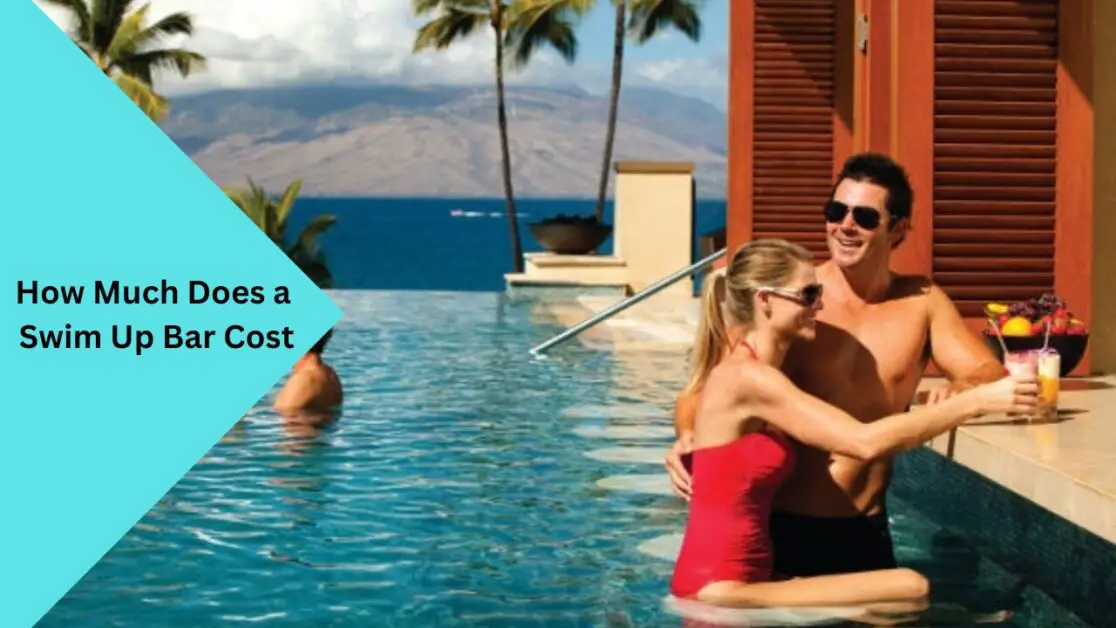Imagine sipping your favorite cocktail while lounging in a pool and enjoying the warm summer breeze. Sounds like a dream, right? Well, with a swim up bar, this dream can become a reality. If you’ve ever wondered about the cost of a swim up bar, you’ve come to the right place. In this comprehensive guide, we’ll dive into the world of swim up bars, explore the pricing factors, and provide all the information you need to know before taking the plunge. So, let’s make a splash and discover how much a swim up bar really costs!
What is a Swim Up Bar?
Before we explore the cost, let’s first understand what a swim up bar is. A swim up bar is a fantastic addition to any pool that allows you to enjoy your favorite beverages without ever leaving the water. Essentially, it’s a bar that is integrated into your swimming pool, allowing you to swim up and order your drink without having to get out of the water.
Swim up bars provide a unique and luxurious experience. They create a focal point in your pool area, and are especially popular for entertaining guests or simply adding a touch of luxury to your backyard oasis. With a swim up bar, you no longer have to interrupt your pool time to grab a drink or leave your guests unattended. It’s convenience and indulgence, all rolled into one!
Cost Factors to Consider
Now that we understand what a swim up bar is, let’s dive into the factors that impact its cost. When it comes to pricing, several factors come into play. Here are the key factors to consider:
- Pool size: The size of your pool will play a role in determining the cost of installing a swim up bar. Generally, larger pools require more materials and labor, which can increase the overall cost.
- Design and customization: The design and level of customization you desire for your swim up bar will impact the cost. Intricate designs and unique features may require more materials and specialized labor, which can increase the price.
- Material selection: The materials used for constructing the swim up bar can vary in cost. Options include concrete, fiberglass, and natural stone. Each material has its pros and cons, and the cost will depend on your selection.
- Additional features: If you wish to incorporate additional features such as built-in seating, underwater lighting, or a water feature, these will add to the overall cost.
- Location and accessibility: The location of your pool and the accessibility for construction can impact the cost. Factors such as sloping terrain or limited space may require additional work, increasing the cost.
- Permit and legal requirements: Before installing a swim up bar, it’s important to check local regulations and obtain any necessary permits. Legal requirements can vary, impacting the overall cost and feasibility.
While these factors influence the price, it’s important to keep in mind that swim up bars can be tailored to fit various budgets. With careful planning and consideration, you can create a swim up bar that meets your needs and design preferences within your desired price range.
Design and Materials
When it comes to the design of your swim up bar, the possibilities are endless. You can choose from various styles and materials to create a bar that complements your pool and suits your aesthetic preferences. Here are some design options to consider:
- L-shaped swim up bar: This design offers ample space for guests to gather and relax while being partially submerged in the water. It provides a comfortable seating area for socializing and enjoying your favorite drinks.
- Circular swim up bar: If you prefer a more intimate and cozy atmosphere, a circular bar might be the perfect choice. It allows for easy conversation and creates a circular flow, ensuring everyone feels included.
- Tropical-themed swim up bar: For a true resort-like experience, consider a swim up bar with a tropical theme. Incorporate thatched roofing, bamboo accents, and vibrant colors to transport yourself to an island paradise.
- Modern and minimalist swim up bar: If sleek and contemporary designs resonate with you, a modern swim up bar might be the way to go. Simple lines, clean edges, and minimalist aesthetics can create a chic and sophisticated look.
When it comes to materials, there are several options to choose from. Each material has its own benefits and considerations. Here are the most common materials used for swim up bar construction:
- Concrete: Concrete is a popular choice due to its durability and versatility. It can be molded into various shapes and sizes to match your design preferences. However, concrete swim up bars may require more maintenance over time.
- Fiberglass: Fiberglass is a lightweight and low-maintenance option. It offers smooth finishes and can be customized to fit your design requirements. However, customization options may be more limited compared to concrete.
- Natural stone: If you desire a luxurious and natural aesthetic, natural stone might be the perfect choice. Options like granite, travertine, or marble can create a visually stunning swim up bar. Keep in mind that natural stone can be more expensive and require regular sealing to maintain its beauty.
Construction and Installation Process
Installing a swim up bar requires careful planning and professional expertise. Here are the general steps involved in the construction and installation process:
- Consultation and design: Work with a professional pool builder or contractor to discuss your design preferences and cost considerations. They will provide guidance and help you visualize your dream swim up bar.
- Excavation and preparation: Once the design is finalized, the construction process begins with excavating the designated area of your pool. This may involve removing dirt, rocks, or any existing structures within the chosen location.
- Frame construction: A sturdy frame is necessary to support the swim up bar structure. Typically, wooden or steel frames are used to create the foundation and shape of the bar. The frame will determine the overall stability and strength of your swim up bar.
- Plumbing and electrical work: The next step involves installing the necessary plumbing and electrical lines for the bar. This includes water supply lines, drainage, electrical outlets, and lighting fixtures. It’s crucial to hire a professional for this stage to ensure safety and compliance with local regulations.
- Bar construction: With the infrastructure in place, the swim up bar itself can be constructed. This includes building the countertop, seating area, and any additional features you desire. The chosen materials will be integrated into the design, creating the desired aesthetic.
- Finishing touches: Once the construction is complete, the swim up bar undergoes finishing touches. This may include waterproofing, sealing, and applying a protective coating to enhance its longevity. The area surrounding the bar is also beautified to seamlessly blend with the rest of your pool and landscaping.
- Final inspection and handover: A final inspection is conducted by the contractor or pool builder to ensure everything is in compliance with regulations and meets your expectations. Once approved, your swim up bar is ready for you to enjoy!
How Deep Should a Swim Up Bar Be?

The depth of the swim up bar is an important consideration to ensure a safe and enjoyable experience for swimmers. While there is no universal depth requirement, here are some factors to consider when determining the depth:
- Comfort and usability: The primary goal of a swim up bar is to provide a comfortable and enjoyable space for swimmers. The depth should allow individuals to sit comfortably on barstools while partially submerged in the water. A depth range of 12 to 18 inches (30 to 46 cm) is commonly recommended.
- Safety considerations: It’s important to strike a balance between comfort and safety. Water levels should be carefully planned to avoid the risk of swimmers accidentally slipping or going underwater. A gradual slope leading to the swim up bar can help ensure a safe and user-friendly experience.
- Local regulations: Local regulations may stipulate specific depth requirements for swim up bars. It is essential to consult with your pool builder and check local guidelines to ensure compliance and avoid any potential legal issues.
Remember, the ideal depth for your swim up bar may vary based on personal preferences and local regulations. Consulting with a professional pool builder will help you determine the best depth that suits your needs.
How High Should a Swim Up Bar Be?
The height of a swim up bar is another crucial factor that contributes to its overall usability and comfort. Here are some considerations when determining the optimal height:
- Ergonomics: The swim up bar should be at a height that allows individuals to comfortably sit on bar stools without straining their posture. The standard height range is typically 42 to 48 inches (107 to 122 cm), but it can be customized based on personal preferences and the intended users.
- Accessibility: The swim up bar should be accessible for individuals of various heights, ensuring that everyone can comfortably reach the countertop. It’s important to consider different age groups and individuals with physical disabilities when determining the height.
- Design cohesion: The height of the swim up bar should complement the overall design and aesthetic of the pool area. It should seamlessly integrate with the surrounding elements, creating a visually pleasing and cohesive space.
By considering these factors, you can determine the ideal height for your swim up bar, ensuring both comfort and functionality.
Maintenance and Additional Costs
Like any other pool feature, swim up bars require regular maintenance and potential repairs to ensure their longevity. Here are some maintenance tasks and additional costs to consider:
- Cleaning and upkeep: Regular cleaning is essential to keep the swim up bar free from dirt, debris, and bacteria. This may involve wiping down the countertop, disinfecting the bar area, and maintaining proper water chemistry. Cleaning schedules and requirements may vary, so it’s advisable to consult with a pool professional.
- Repairs and renovations: Over time, swim up bars may require repairs or renovations due to wear and tear or changes in design preferences. Factors such as replacing bar stools, repairing plumbing or electrical issues, or updating the aesthetics may lead to additional costs.
- Heating and insulation: If you plan to use your swim up bar year-round or in colder climates, heating and insulation options may be necessary. These additional features will increase the initial installation cost and may contribute to ongoing operating costs.
- Professional services: Depending on your preferences and expertise, you may choose to hire professional services for maintenance, repairs, or renovations. It’s helpful to budget for these services to ensure the longevity and functionality of your swim up bar.
By factoring in these maintenance tasks and potential additional costs, you can make informed decisions and enjoy your swim up bar for years to come.
Conclusion
Congratulations! You’ve dived into the world of swim up bars and gained a comprehensive understanding of their cost, design considerations, construction process, and maintenance requirements. Remember, the cost of a swim up bar can vary based on factors such as pool size, design, materials, and additional features. By working with a professional pool builder and considering your budget, you can create a swim up bar tailored to your needs and preferences.
So, why wait? Take your poolside experience to the next level with a swim up bar. Enjoy the convenience, luxury, and relaxation it brings, all without leaving the water. Cheers to transforming your backyard into an oasis of fun and relaxation!

Greetings, fellow pool enthusiasts! I’m Turner Davis, your dedicated guide to the world of pool care and maintenance. With over a decade of experience in the field, I’ve made it my mission to transform ordinary pools into extraordinary aquatic retreats.

